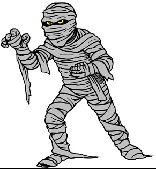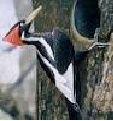Natural Solutions to Things That Bug You (24 page)
Read Natural Solutions to Things That Bug You Online
Authors: Myles Bader

If you have a plant that is already infested, place the plant into a plastic bag and blow a good quantity of cigarette smoke into the bag then seal it up with a tie. This will kill any bug that is in the plant. Allow it to remain overnight and hopefully the plant will survive the smoke.
DON’T BECOME A BUG MAGNET

 A variety of different bugs are attracted to different colored clothing. If you wear blue the thrips will follow you around and whiteflies love yellow. Best to wear basic brown or green since these colors don’t seem to attract bugs.
A variety of different bugs are attracted to different colored clothing. If you wear blue the thrips will follow you around and whiteflies love yellow. Best to wear basic brown or green since these colors don’t seem to attract bugs.

SPRAY THEM WITH COOKING OIL
Aphids will suffocate if sprayed with cooking oil. You can make a cooking oil spray by adding 1 teaspoon of insecticidal soap and ½ teaspoon of cooking oil to 1 quart of water. You can also use a commercial spray, such as Pam™.
GETTING TO THE ROOT OF THE PROBLEM
Cassava root is a very effective root when it comes to controlling aphids. You will need to crush the root to obtain the juice then dilute it with equal parts of juice to equal parts of water.
Spray the area, affected by the aphids immediately and wait 15-20 days before planting.

PLOW UP YOUR GARDEN
If you plow up your garden in the fall it should eliminate the aphid eggs. Then if you plant some mint plants that will end their cycle.
LIME DOES MAGIC
Use ¼ cup of lime
(use with caution)
in 1 gallon of warm tap water, add 4 drops of liquid soap and place the mixture in a sprayer. A soap that works really well is
Ringer Aphid-Mite Attack Insecticidal Soap™
.
MARIGOLD SOLUTION
 To get rid of aphids, just soak 15 mature diced-up marigold plants in 5 pints of boiled water and allow the mixture to cool before adding 3 drops of liquid soap. Strain and spray on the affected areas and be sure to spray the underneath sides of the leaves.
To get rid of aphids, just soak 15 mature diced-up marigold plants in 5 pints of boiled water and allow the mixture to cool before adding 3 drops of liquid soap. Strain and spray on the affected areas and be sure to spray the underneath sides of the leaves.
SWEET POTATO WATER
Next time you boil sweet potatoes be sure and save all the water to use in a spray to get rid of aphids. This works really well on small insects such as aphids and ants. The leaves of the sweet potato plant can also be soaked in water and the water used as a very effective spray.
WOOLLY MAMMOTH - NO RELATION TO WOOLLY APHID
 Tea (cammelia sinensis) can be very effectively used to combat woolly aphids. The leaves are high in caffeine and can be used to prepare a spray.
Tea (cammelia sinensis) can be very effectively used to combat woolly aphids. The leaves are high in caffeine and can be used to prepare a spray.
Make a tea from the leaves and allow it to cool then place the tea in a sprayer and spray the aphids. The crushed tea, leaves can also be placed around plants as a deterrent.
TOMATO JUICE SPRAY
2 Cups tomato leaves and stems
1 Quart of tap water
Grind-up the tomato parts them process them in a food processor with 2 cups of water. Allow the mixture to stand overnight, then strain it and add 2 more cups of water. Use as a spray to get rid of aphids.

DON’T BE SCARED OF THIS MUMMY
If you are aphid hunting and spot an aphid that is swollen and looks metallic, brown or blackened, you have found a “mummy.” This is an aphid that has been parasitized by a wasp. Don’t kill it or you will kill the wasp larva.
A PLANT REPELLENT
If you plant nasturtiums around plants that are susceptible to aphid attacks it will keep the aphids away. Garlic and onion plants are almost as good but nasturtiums seem to be more effective.
FOILED AGAIN
Placing aluminum foil around plants that aphids like seems to work very well; in fact, it tends to keep a number of insects away due to the reflection from the aluminum foil, which confuses the insect. This also aids in reducing weeds and helps the soil retain moisture.
THE CLAY KILLER
A dilute solution of soft wet clay will kill the soft-bodied aphids.
RUB-A-DUB-DUB
Be gently and rub the affected leaves between your fingers to remove the aphids. This method has been the preferred method for hundreds of years.
SQUASH THAT BUG & CHASE HIS FRIENDS AWAY
If you find a plant that is infested with aphids, just crush up a few and leave them on the plant. When they are crushed they will release a chemical signal and all the other aphids will leave the plant.
BORERS
General Information:
There are two main types of borers; they are the caterpillars that eat plants and the grubs of beetles that attack trees.
They are called borers because they can bore into the plant or tree and proceed to feast on the insides, usually in an upward direction. They are difficult to find before they do a great deal of damage.
Tree diseases in many trees can usually be traced to borers, especially if you have plants or trees that are weak and undernourished. These weak trees or plants are prime targets for borers.
 Woodpeckers love to go after borers and find them a tempting meal. If the trees are wrapped, however, it usually stops most borers from getting up the tree and getting a foothold. If you can spot the gum and sawdust mixture that they leave behind when they are boring into the tree, it is best
Woodpeckers love to go after borers and find them a tempting meal. If the trees are wrapped, however, it usually stops most borers from getting up the tree and getting a foothold. If you can spot the gum and sawdust mixture that they leave behind when they are boring into the tree, it is best to locate and go after them right away.
to locate and go after them right away.